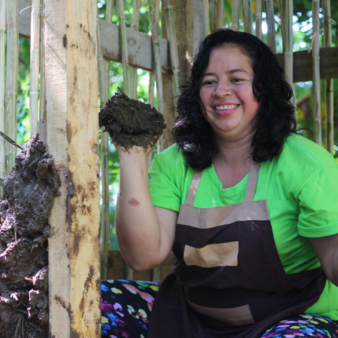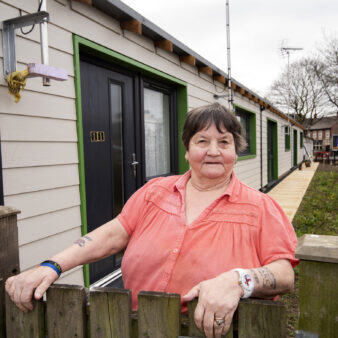This environmentally and socially sustainable eco-village in Cali includes 222 homes as well as recreational facilities and community gardens. It was initiated by FENAVIP working together with the local community. The low-cost earthquake-resistant homes were constructed by the residents themselves through mutual help. Wherever possible, environmentally friendly building materials have been used, including recycled debris and sugar cane ash.
Project Description
Aims and Objectives
- To provide housing for low-income households and improve their quality of life.
- To create an eco-village, based on the principles of social and environmental sustainability.
- To establish sustainable housing funding mechanism for low-income families who do not have access to formal credit.
Considered one of the most dangerous cities in the world, Cali possesses a high housing deficit, both quantitative and qualitative, that affects primarily the population with the lowest income level. The housing conditions of this sector of the population are typically characterised by insecure land tenure, overcrowded conditions, lack of infrastructure and services and a lack of green space and facilities for social and community development. In recent times, there has been an increase in organised crime and a breakdown in social networks and solidarity within communities. The Ecobarrio Suerte 90 project is designed to address a range of physical, social and environmental issues affecting Cali’s urban poor.
Ecobarrio Suerte 90 is Colombia’s first eco-village. It is composed of 13 residential blocks with full urban infrastructure, housing 270 low-income families in the city of Cali.
This project provides secure land tenure to families and houses are made of materials designed to be earthquake-resistant in a region prone to seismic activity. Housing units are incremental, with a basic 30.8m2 single-storey unit covered by a concrete slab, which allows for future upward expansion of 29m2, for a total area of nearly 60m2. All dwellings have been built by the residents themselves using environmentally friendly building materials and systems where possible.
In addition to housing, the eco-village includes individual and collective vegetable gardens, community service facilities such as a community centre, drugstore, restaurant and shops. Two large areas, each measuring approximately 1,200m2, have been set aside for the creation of an ‘active’ recreational park with sports facilities and a ‘passive’ park for leisure activities. Suerte 90 also includes a ‘Native Germoplasm Bank’ for the cultivation of 12 endangered species of native fruit trees, an integrated system for the management of solid waste, the creation of agricultural production cooperatives as part of a regional food security project and cultural programmes for young people.
The project encourages residents to work together in the planning and overall management of the project including housing construction, agricultural work cooperatives, community activities and decision-making. FENAVIP has worked with the community to grow medicinal and aromatic plants and organic vegetables. The eco-village also includes communal green areas including two parks, a ‘Native Germoplasm Bank’ for the cultivation of endangered species of native fruit trees and the creation of agricultural production cooperatives as part of a regional Food Security project. The project also works to raise awareness and provide training to residents in the treatment and management of organic residues (used as fertiliser for cultivation in gardens) and the disposal and separation of domestic waste.
The project has so far has benefited 270 families with an average annual household income of $116, which represents the lowest income level in the country. Working in collaboration with FENAVIP and the Social Housing Department of the city of Cali, residents actively participate in planning and decision-making and are responsible for the ongoing management of the project.
The total capital costs were $1.86 million, including the cost of land, housing subsidies and credit. Serviced land and funding for housing construction were provided by the Social Housing Department Housing Fund, and additional housing subsidies were provided by COMFANDI (190 families), COMFENALCO (17 families) and Inurbe (63 families) at a rate of $3,078 per household. Each dwelling has a total cost of $6,750. Residents manage the project and contribute their labour as well as financial resources through a savings scheme developed by FENAVIP.
The project has greatly improved housing conditions and increased the quality of life of the residents. Vulnerable, low-income families previously living in precarious housing conditions now have safe homes and secure land tenure as well as improved opportunities for income generation.
Why is it innovative?
- This is the first eco-village in Colombia, with a focus on environmental as well as social sustainability. The eco-village concept is also innovative within the Latin American context.
- The project incorporates earthquake-resistant building materials made from recycled debris and sugar cane ashes.
- The project combines aspects of social and environmental sustainability including self-management of the project by the community and the appropriate use of energy and natural resources.
What is the environmental impact?
The project uses environmentally-friendly building materials and systems and is the first housing project to incorporate a range of pioneering building materials made from recycled debris and sugar cane ashes to make cement, bricks and blocks. These earthquake-resistant materials, which use locally available waste products as raw material, can be produced in half the time and at a 20 per cent reduction in cost in comparison to conventional bricks and concrete blocks. Other materials used include micro-concrete and cement made from pieces of rubble.
Environmental impacts in the wider sphere stem from the preservation of rare plant species, the establishment of green areas within an urban context, organic food production, the management of organic waste and the appropriate use of water and energy resources.
Is it financially sustainable?
Although the project relies on government housing subsidy, the savings and credit mechanism developed by FENAVIP helps to ensure continuity and resident involvement in the funding process.
The programme has resulted in improved opportunities for income generation, especially with the establishment of agricultural production cooperatives that are cultivating organic produce for internal consumption as well as commercial purposes which has benefited the community as a whole. The combination of housing subsidies and FENAVIP’s low-interest savings and credit scheme has made housing affordable and accessible to the poorest sectors of the population.
What is the social impact?
The project works toward the empowerment of socially excluded groups, the establishment of equal gender relations and the equitable distribution of land and of wealth through collective income-generating activities (work cooperatives).
FENAVIP works to strengthen social housing movements, supporting them in the struggle for the right to land and housing, encouraging the active participation of residents and empowering communities through the establishment of self-management processes.
Barriers
- Lack of available funding for community facilities.
- Delay in obtaining government approval for the family housing allowances.
- Delay in the payment of family housing allowances.
Lessons Learned
- Self-management of the project by community residents is essential to creating a sustainable community.
- Problems resulting from the internal conflict in Colombia can only be resolved through initiatives that foster dialogue, effective participation and tolerance.
Transfer
Elements of the project, such as materials used and savings and credit mechanisms, have been taken up by other organisations in Latin America who have either visited the project or attended seminars where the experience has been presented.
Partnership
NGO, CBO, Local Government


